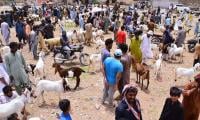HYDERABAD: Toxic wild plants and grasses growing in different grazing fields after recent rains and consequent flooding in Sindh have been making livestock and small animals sick in several districts of the province, veterinary practitioners said.
Rains have given hope to farmers and herders, who depend on it for cultivation, replenishing underground water resources, and managing grazing fields, but the growth or increased abundance of many toxic plants is not something they are used to dealing with.
As large swathes of arid and semiarid zones have turned green after rains, herders go to the fields with their animals. Some have reported of paralysis and sickness in several animals, and seem unable to identify the responsible flora.
Dr Irfan Marnas, veterinary practitioner and a trainer for community farmers, sharing reports he received during interaction with herders, said, “They (traditional farmers) seem unable to identify the poisonous plants. Obviously these toxic plants look similar to herbal flowers, but they are harmful for humans as well as livestock.”
He said there is one common plant known as parthenium hysterophorus, locally called gajar booti, which was poisonous. “It is spreading in different areas, both irrigated land and arid zones.”
Many small and big animals have reportedly fallen sick after consuming toxic shrubs and grasses in mountainous areas of Jamshoro district and Thar Desert. Farmers have observed paralysis in one or two herd animals after reaching their makeshift farms or even in the fields.
Dr Marnas said hundreds of plant species have grown in natural fields where animals are grazing. During these days with greenery all around animals seem eager to consume fresh plants and accidentally eat poisonous grasses, which cause problems for them.
Muhammad Siddique, working with local communities in Thar Desert, confirmed reports of small animals getting disabled after consuming toxic plants. “I have received reports from two-three neighbouring villages about the issue, which is on a small scale. But livestock department officials should check the issue to avoid losses, as farmers’ livelihoods depended on livestock,” he said.
Tharparkar district has more than six million small and big animals, contributing several products to the dairy sector. Livestock is a major contributor of nutrient food, which is the most basic need of people.
Earlier, farmers were able to identify some strange toxic plants, which had created problems for them, but now they are unable to identify the responsible flora which was causing problems.
Dr Aijaz Kumbhar, area adviser at foreign funded Dairy Beef Project, belonging to a village in Badin district, sharing borders with Tharparkar also claimed to have received information from grazing fields.
It was the responsibility of academia and research institutes to conduct a fresh study to identify wild plants in the fields with their description, scientific names and nutrient value or toxicity level for animals. This would also help learn how many native plants have depleted due to climate change and replaced by strange plants, which were creating problems.
“There is a chain of people from scientists to veterinary officials and (livestock) farmers, who possess herds. But it seems there is a gap within this chain in terms of identifying the issues faced by farmers,” Dr Kumbhar said, adding that scientists and researchers might have knowledge, which should be passed on to officials in fields and then moved to farmers at grassroots level to avoid losses.
“Energy and proteins are must to save animals. But now the system has been changed because of depletion of valuable plants and practices by farmers,” he said.
Giving examples, he said one source of protein was seeds. In the past, ghanis were used to extract oil from seeds, turning what remained into seed cakes. Those seed meals helped improve the body of animals. But the old mechanism has changed.
“Similarly the other source is energy which we used to get from grains, like wheat, rice and a variety of pulses for animal feed. This practice has also been changed by herders to maintain the productivity of animals through investment,” he said.
Earlier, seed cakes made via ghanis used to have 18-20 percent protein, but since new machines were introduced, findings show only eight percent protein in seed meals. A gap has developed among farmers when it comes to knowing about the food chains and new processes. There is need to fill this gap with knowledge sharing at the grassroots level to save valuable livestock and other assets.
The veterinary practitioners said this gap should be filled with fresh studies about the flora growing in the various parts of the province, the nutritional value of the flora, and the impacts of climate change, as well as the reasons behind the increasing toxicity in the environment.
The headquarters of the Sui Southern Gas Company . — APP FileKARACHI: Sui Southern Gas Company has launched a fresh...
The logo of the ExpoMed Eurasia. — CA MI websiteKARACHI: Pakistan is participating in ExpoMed Eurasia, a leading...
Gold bars are seen in this undated file photo. — AFP/FileKARACHI: Gold prices increased by Rs500 per tola on...
FFBL Head Office building can be seen in Islamabad. — FFBL WebsiteKARACHI: Fauji Fertilizer Bin Qasim Limited has...
Representational file of an BMW car. — AFP FileLAHORE: Small improvements in economic credentials of the country are...
A fuel station worker filling petrol in vehicle at a fuel station in Karachi on Tuesday, April 16, 2024KARACHI: After...







